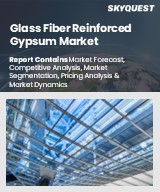
세계의 유리섬유 강화 석고 시장 규모는 2023년에 44억 달러로 평가되며, 2024년 46억 7,000만 달러에서 2032년에는 75억 6,000만 달러로 성장하며, 예측 기간(2025-2032년)의 CAGR은 6.2%로 성장할 전망입니다.
세계 유리섬유 강화 석고 시장은 건축에서 지속가능한 대안으로 석고 패널에 대한 수요 증가에 힘입어 크게 성장하고 있습니다. 이러한 추세는 기존 콘크리트에 비해 더 가벼운 건축자재에 대한 요구와 건설 관행에서 지속가능성을 중시하는 추세에서 비롯된 것입니다. 유리섬유 강화 석고의 장점은 저탄소 배출량, 내화성, 내구성, 불연성, 불연성, 폐기물 제로 등으로 급속한 주택 개발에 매력적인 선택이 되고 있습니다. 또한 건축공학과 지속가능한 재료의 발전은 그 매력을 더욱 높여주고 있습니다. 높은 강도 대 중량비를 가진 이 소재는 벽과 천장에 다양한 용도로 사용할 수 있으며, 건축가는 프로젝트 비용과 시공 효율을 최적화하면서 기능성과 미적 요구를 모두 충족시킬 수 있습니다.
Global Glass Fiber Reinforced Gypsum Market size was valued at USD 4.4 billion in 2023 and is poised to grow from USD 4.67 billion in 2024 to USD 7.56 billion by 2032, growing at a CAGR of 6.2% during the forecast period (2025-2032).
The global glass fiber reinforced gypsum market is experiencing significant growth, fueled by the increasing demand for gypsum panels as sustainable alternatives in construction. This trend stems from the desire for lighter building materials compared to traditional concrete, and the emphasis on sustainability in construction practices. The advantages of glass fiber reinforced gypsum include its low carbon footprint, fire resistance, durability, non-combustibility, and zero waste production, making it an attractive option for rapid residential housing developments. Furthermore, advancements in architectural engineering and sustainable materials are enhancing its appeal. With a high strength-to-weight ratio, this material allows for diverse applications in walls and ceilings, enabling architects to fulfill both functional and aesthetic requirements while optimizing project costs and construction efficiency.
Top-down and bottom-up approaches were used to estimate and validate the size of the Global Glass Fiber Reinforced Gypsum market and to estimate the size of various other dependent submarkets. The research methodology used to estimate the market size includes the following details: The key players in the market were identified through secondary research, and their market shares in the respective regions were determined through primary and secondary research. This entire procedure includes the study of the annual and financial reports of the top market players and extensive interviews for key insights from industry leaders such as CEOs, VPs, directors, and marketing executives. All percentage shares split, and breakdowns were determined using secondary sources and verified through Primary sources. All possible parameters that affect the markets covered in this research study have been accounted for, viewed in extensive detail, verified through primary research, and analyzed to get the final quantitative and qualitative data.
Global Glass Fiber Reinforced Gypsum Market Segments Analysis
Global Glass Fiber Reinforced Gypsum Market is segmented by Application, Form, End-use sector, Key Properties and region. Based on Application, the market is segmented into Interior Walls, Exterior Walls, Ceilings, Flooring and Other Applications. Based on Form, the market is segmented into Boards, Panels, Blocks, Tiles and Other Forms. Based on End-use sector, the market is segmented into Residential Buildings, Commercial Buildings, Industrial Buildings, Infrastructure Projects and Other End-Use Sectors. Based on Key Properties, the market is segmented into Fire Resistance, Moisture Resistance, Sound Absorption, Lightweight, Durability and Other Key Properties. Based on region, the market is segmented into North America, Europe, Asia Pacific, Latin America and Middle East & Africa.
Driver of the Global Glass Fiber Reinforced Gypsum Market
The growing emphasis on sustainable and energy-efficient construction practices is significantly driving the demand for glass fiber reinforced gypsum (GFRG) in civil engineering projects. Known for their low carbon footprint, recyclability, and excellent thermal insulation, GFRG panels play a pivotal role in facilitating projects that aim for green certifications. Their lightweight yet robust nature aligns well with regions embracing sustainable building methods in response to economic growth. Architects, builders, and planners are increasingly incorporating GFRG products into both public and private sector strategies for sustainable urban development. Furthermore, GFRG enhances transportation efficiency and speeds up construction, contributing to reduced emissions and promoting a positive image of energy-efficient building practices.
Restraints in the Global Glass Fiber Reinforced Gypsum Market
The Global Glass Fiber Reinforced Gypsum market faces several challenges that impede its growth, despite its recognized advantages. One significant obstacle is the limited awareness and understanding of this material among contractors and builders, who often prefer conventional options such as concrete or brick due to familiarity and existing training practices. In many developing regions, the hesitance to adopt glass fiber reinforced gypsum stem from misconceptions and insufficient knowledge about its cost-efficiency and performance benefits. Furthermore, while the installation of this material is generally straightforward, it can necessitate specialized training that may be inaccessible in rural or semi-urban areas, leading to potential implementation delays and improper application.
Market Trends of the Global Glass Fiber Reinforced Gypsum Market
The Global Glass Fiber Reinforced Gypsum market is witnessing a significant trend towards the integration of smart technologies within glass fiber reinforced gypsum panels. These innovative panels are evolving from traditional passive building materials to advanced solutions embedded with sensors that facilitate real-time monitoring of critical environmental parameters such as humidity, temperature, and structural integrity. This shift not only enhances the functionality of building materials but also offers valuable insights for the maintenance and management of larger commercial spaces and institutions, ultimately driving efficiency and safety in building operations. The incorporation of such smart features is poised to redefine industry standards and expectations.